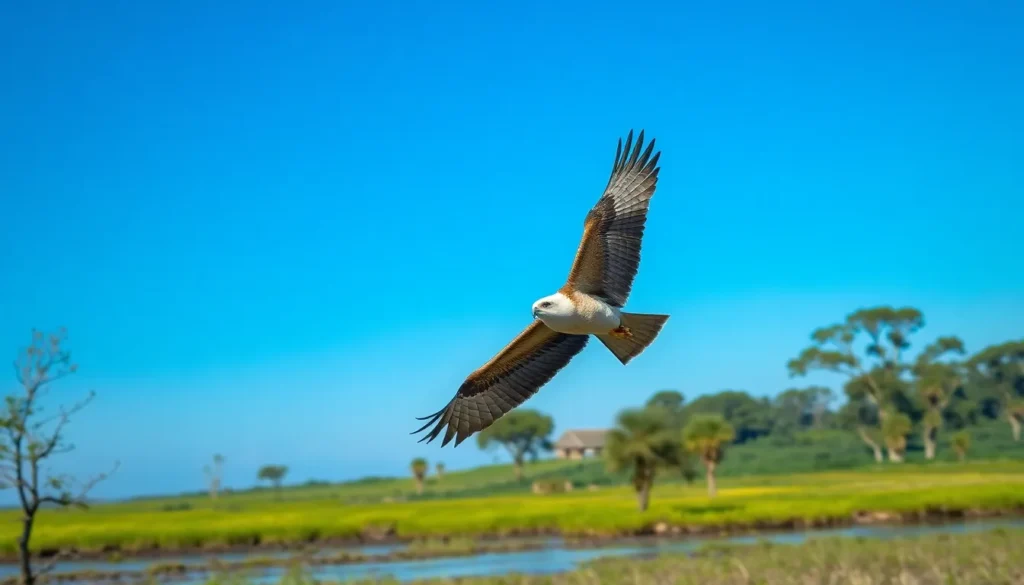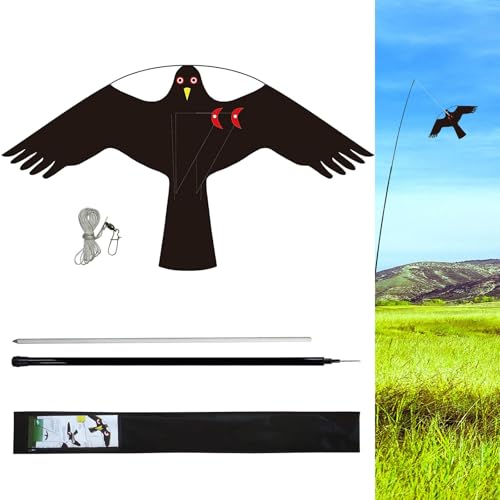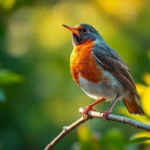When we think of aerial masters soaring effortlessly through the sky, kite birds immediately come to mind as some of nature’s most skilled hunters. These magnificent raptors have captivated birdwatchers and wildlife enthusiasts for centuries with their graceful flight patterns and impressive hunting techniques.
We’ve all witnessed their distinctive silhouettes gliding high above open fields and wetlands, but there’s so much more to discover about these remarkable birds of prey. From their unique feeding habits to their incredible migration journeys, kite birds showcase adaptations that make them true survivors in diverse ecosystems worldwide.
Whether you’re a seasoned birder or simply curious about wildlife, understanding kite birds opens up a intriguing area of avian behavior and ecological importance. Let’s explore what makes these aerial acrobats such extraordinary creatures and why they deserve our attention and protection.
What Is a Kite Bird?
Kite birds belong to the family Accipitridae and represent a diverse group of raptors found across multiple continents. These medium-sized birds of prey display distinctive characteristics that set them apart from other raptors like hawks and eagles.
Physical features define kite birds through their angular wings and relatively light build compared to other raptors. Most species measure between 20-26 inches in length with wingspans ranging from 43-60 inches. Their wings appear long and narrow with pointed tips that create their signature silhouette during flight.
Behavioral patterns distinguish kites through their soaring abilities and opportunistic feeding strategies. Unlike many raptors that rely primarily on active hunting, kites often scavenge and exploit various food sources including fish, small mammals, insects, and carrion.
Distribution spans across six continents with over 20 species inhabiting diverse ecosystems. Red kites populate parts of Europe and Asia, while Mississippi kites breed throughout North America. Black kites maintain the widest global distribution among all raptor species.
| Kite Species | Primary Range | Wingspan (inches) | Diet Focus |
|---|---|---|---|
| Red Kite | Europe, Asia | 57-65 | Small mammals, carrion |
| Black Kite | Global (except Americas) | 43-60 | Fish, insects, refuse |
| Mississippi Kite | North America | 29-37 | Flying insects |
| Brahminy Kite | South/Southeast Asia | 43-52 | Fish, crustaceans |
Habitat preferences vary significantly among species but most kites favor open landscapes near water sources. Wetlands, grasslands, and agricultural areas provide optimal hunting grounds where these birds can spot prey from considerable heights.
Flight mechanics showcase the kite bird’s mastery of thermal currents and wind patterns. Their lightweight bone structure and efficient wing design allow for extended periods of effortless soaring with minimal energy expenditure.
Physical Characteristics of Kite Birds

Kite birds exhibit remarkable physical adaptations that distinguish them from other raptors in the family Accipitridae. These aerial hunters possess unique structural features that enable their exceptional soaring abilities and opportunistic feeding behaviors.
Size and Wingspan
Kite birds demonstrate considerable variation in size across different species, with most measuring between 20-26 inches in body length. The wingspan measurements range from 43-60 inches, providing these raptors with exceptional lift and maneuverability during flight.
Red Kites represent the larger end of the spectrum, reaching lengths up to 26 inches with wingspans extending to 60 inches. Black Kites typically measure 22-24 inches in length, while Mississippi Kites are among the smaller species at approximately 20-21 inches. White-bellied Sea Eagles, though technically kites, reach impressive sizes of up to 34 inches with wingspans exceeding 70 inches.
| Species | Body Length (inches) | Wingspan (inches) | Weight (pounds) |
|---|---|---|---|
| Red Kite | 24-26 | 57-60 | 2.2-3.3 |
| Black Kite | 22-24 | 47-52 | 1.3-2.4 |
| Mississippi Kite | 20-21 | 43-47 | 0.6-0.9 |
| White-bellied Sea Eagle | 28-34 | 70-87 | 5.5-9.9 |
Distinctive Features and Coloration
Kite birds possess angular wing shapes that create their signature silhouette during soaring flight. The wing structure features long primaries and relatively broad secondaries, allowing for efficient thermal riding and precise aerial maneuvering.
Forked tails characterize many kite species, with Red Kites displaying the most pronounced fork shape that aids in steering and stability. Black Kites exhibit slightly less pronounced tail forks, while Mississippi Kites show minimal forking. Swallow-tailed Kites possess the most dramatic tail fork among North American species.
Plumage coloration varies significantly among kite species, with most displaying earth tone combinations. Red Kites feature reddish brown bodies with distinctive white patches on their wing undersides and pale heads marked with fine streaking. Black Kites present darker brown plumage overall, though their name proves misleading as they rarely appear truly black.
Mississippi Kites showcase blue-gray bodies with darker flight feathers and distinctive red eyes in adults. White-bellied Sea Eagles display stark white heads, breasts, and bellies contrasting with dark brown wings and backs. Brahminy Kites exhibit bright chestnut plumage with distinctive white heads and breasts.
Beak structure reflects their opportunistic feeding habits, featuring moderately curved bills that prove less hooked than those of active predators like hawks and eagles. The relatively weak feet and talons of most kite species indicate their preference for scavenging and catching smaller, less aggressive prey compared to other raptors.
Different Species of Kite Birds
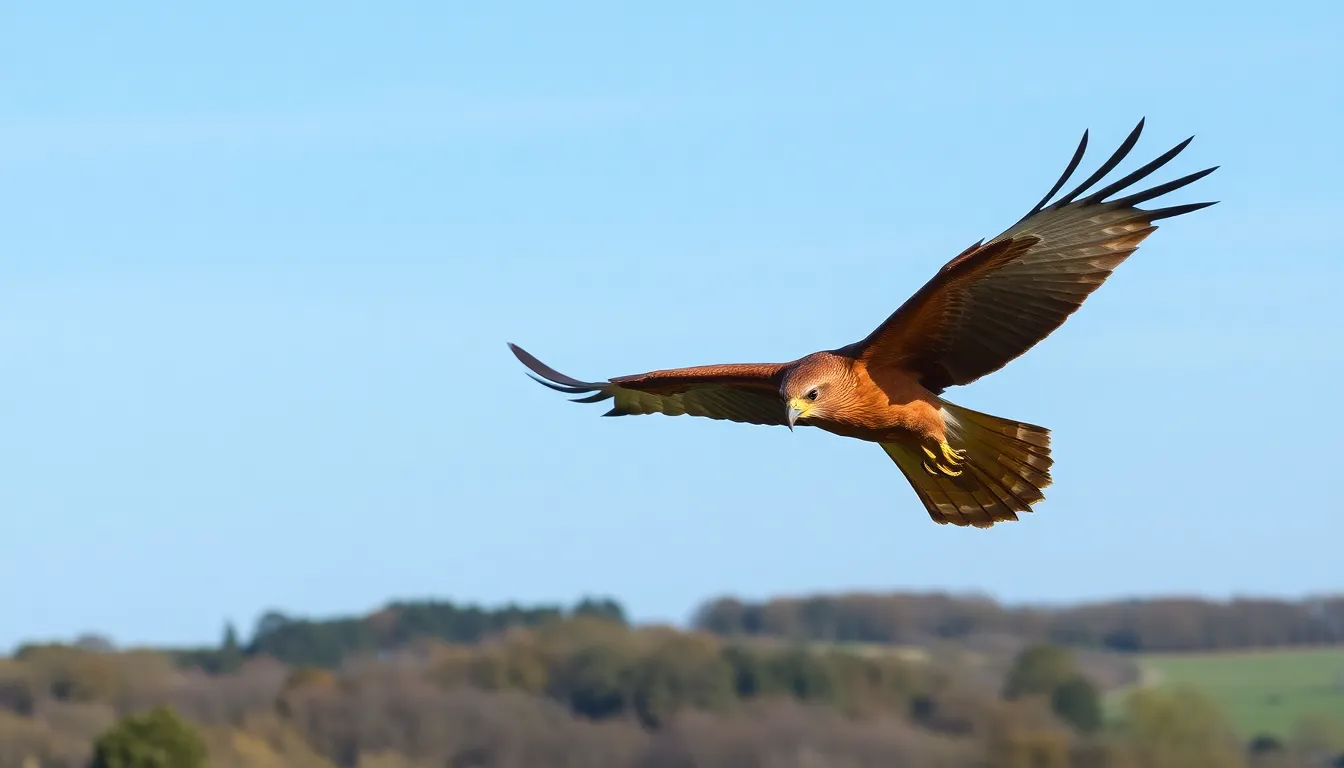
The diverse kite bird family encompasses over 20 distinct species distributed across six continents. Each species exhibits unique characteristics adapted to their exact environments and hunting strategies.
Red Kite
Red Kites (Milvus milvus) rank among the largest kite species with their impressive 60-inch wingspan and distinctive russet-colored plumage. These magnificent birds inhabit deciduous woodlands and open countryside across Europe and parts of Asia, preferring areas with mature trees for nesting and adjacent grasslands for hunting.
Their forked tails display prominent rufous coloration with darker flight feathers creating striking contrast during soaring displays. Red Kites exhibit exceptional scavenging abilities, feeding primarily on carrion, small mammals, birds, fish, and various invertebrates found in their territories.
Breeding pairs construct large nests in tall trees using sticks, wool, and other materials collected from surrounding areas. Conservation efforts have successfully restored Red Kite populations in regions where they previously faced extinction, particularly in Wales and parts of England.
Black Kite
Black Kites (Milvus migrans) demonstrate the most extensive global distribution among all kite species, inhabiting Europe, Asia, Africa, and Australia. These adaptable raptors measure approximately 24 inches in length with wingspans reaching 60 inches, displaying dark brown plumage with lighter streaking patterns.
Opportunistic feeding behaviors characterize Black Kites as they exploit diverse food sources including fish, small mammals, reptiles, insects, and human food waste. Urban environments attract these birds due to abundant scavenging opportunities around markets, garbage dumps, and waterfront areas.
Migration patterns vary significantly among Black Kite populations, with European breeding birds traveling thousands of miles to African wintering grounds each autumn. Their slightly notched tails distinguish them from Red Kites, appearing less deeply forked during flight observations.
Mississippi Kite
Mississippi Kites (Ictinia mississippiensis) represent the smallest North American kite species at 20-24 inches in length with 43-inch wingspans. These graceful raptors breed across the southeastern United States, constructing nests in tall trees within riparian forests and urban parklands.
Insectivorous feeding habits set Mississippi Kites apart from other kite species, as they capture flying insects including dragonflies, cicadas, grasshoppers, and beetles during aerial hunting flights. Their streamlined bodies and pointed wings provide exceptional maneuverability for pursuing agile insect prey.
Adults display slate-gray plumage with darker flight feathers and distinctive white patches on their secondary wing feathers visible during flight. These remarkable migrants undertake lengthy journeys to South American wintering grounds, traveling over 4,000 miles twice annually between breeding and wintering territories.
Habitat and Distribution
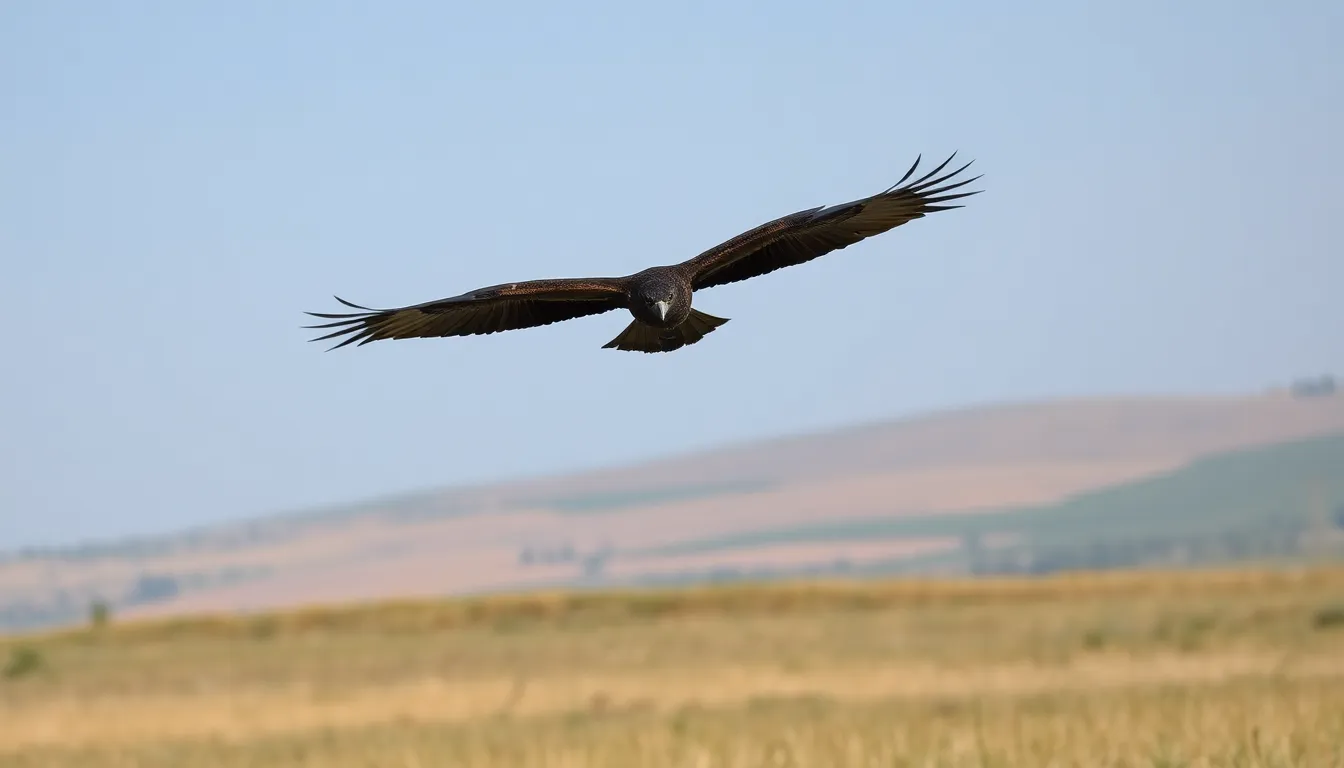
Kite birds occupy diverse ecosystems across six continents, demonstrating remarkable adaptability to various environmental conditions. These aerial specialists select habitats that optimize their soaring abilities and opportunistic feeding strategies.
Preferred Environments
Kite birds thrive in open landscapes where thermal currents enhance their effortless flight patterns. Grasslands provide abundant small mammal populations and insect swarms that form essential food sources for multiple species. Agricultural areas attract kites through their concentration of rodents and carrion opportunities, particularly during harvest seasons.
Wetland margins serve as critical habitats for fish-eating species like the Brahminy Kite and White-bellied Sea Eagle. These environments offer consistent water sources and diverse prey options including fish, amphibians, and aquatic insects. Coastal regions support specialized kite populations that exploit marine resources and benefit from consistent oceanic wind patterns.
Forest edges combine the benefits of woodland protection with open hunting grounds. Red Kites particularly favor these transitional zones where deciduous woodlands meet agricultural fields. Riparian corridors create natural highways for kite movement while providing nesting sites and abundant prey concentrations.
Urban environments increasingly support adaptable species like Black Kites, which exploit human food waste and disturbed habitats. These metropolitan areas provide consistent thermal updrafts from concrete surfaces and year-round food availability through waste management sites.
Global Range and Migration Patterns
| Species | Continental Range | Migration Distance | Seasonal Pattern |
|---|---|---|---|
| Black Kite | Africa, Asia, Europe, Australia | Up to 6,200 miles | Partial migrant |
| Red Kite | Europe, Asia | 1,200-2,500 miles | Short to medium distance |
| Mississippi Kite | North America to South America | 4,500+ miles | Complete migrant |
| Brahminy Kite | South Asia, Southeast Asia, Australia | Non-migratory | Resident |
Black Kites demonstrate the most extensive global distribution among all kite species, inhabiting every continent except Antarctica and the Americas. European populations migrate to sub-Saharan Africa during winter months, following ancient flyways through the Middle East and along the Nile River valley. Asian populations exhibit varied migration strategies, with northern breeding birds traveling to Southeast Asia and India.
Red Kites concentrate primarily in temperate regions of Europe and Asia, with the largest populations residing in Germany, Wales, and the United Kingdom. British Red Kites remain largely sedentary due to mild maritime climates, while Scandinavian populations migrate south to escape harsh winter conditions. Reintroduction programs have successfully established new populations in Scotland and England following near-extinction events.
Mississippi Kites complete extraordinary transcontinental journeys from breeding grounds across the southeastern United States to wintering areas in South America. These small raptors travel approximately 4,500 miles each way, crossing the Gulf of Mexico in single flights lasting up to 18 hours. Fall migration occurs from August through September, with spring return flights concentrated in April and May.
Swallow-tailed Kites inhabit wetland ecosystems from the southeastern United States to Argentina, following river systems and coastal plains during migration. Snail Kites maintain restricted ranges in Florida’s Everglades and South American wetlands, demonstrating specialized habitat requirements tied to apple snail populations.
Behavior and Feeding Habits
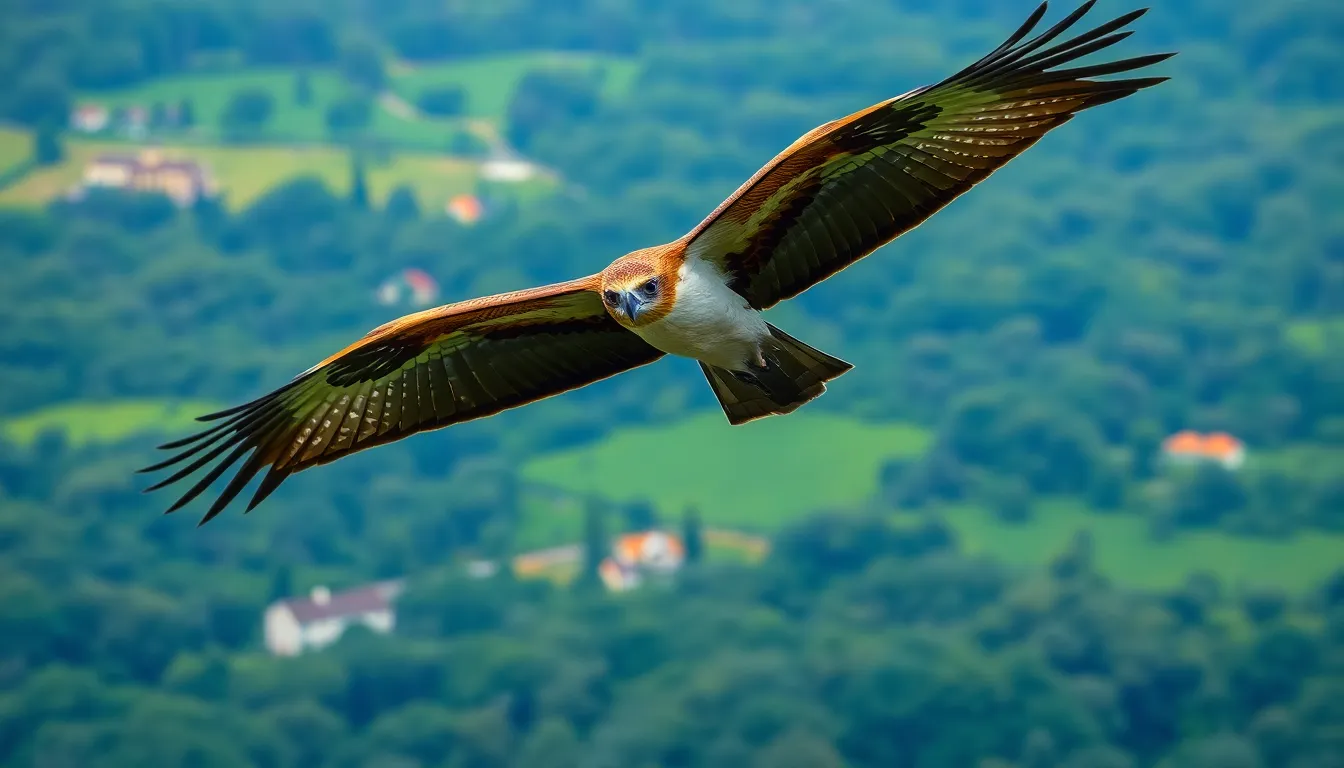
Kite birds demonstrate remarkable behavioral adaptations that distinguish them from other raptors through their opportunistic feeding strategies and efficient aerial techniques. We observe these magnificent hunters employing diverse methods that capitalize on their exceptional soaring abilities and keen eyesight.
Hunting Techniques
Kite birds use passive hunting strategies that maximize energy conservation while maintaining hunting effectiveness. Soaring at altitudes between 150-300 feet allows kites to survey vast territories for feeding opportunities without expending excessive energy.
Thermal riding represents the primary hunting method among most kite species. Red Kites circle in rising air currents for periods extending 2-4 hours while scanning ground surfaces for carrion and small prey items.
Opportunistic scavenging forms the foundation of kite hunting behavior across multiple species. Black Kites gather around fishing operations, garbage dumps, and roadside carcasses where concentrated food sources provide reliable nutrition.
Aerial insect catching distinguishes Mississippi Kites from their relatives through specialized flight maneuvers. These agile hunters perform swift dives and banking turns to capture flying insects including dragonflies, beetles, and cicadas during peak activity periods.
Water surface skimming allows certain kite populations to exploit aquatic food sources. Brahminy Kites demonstrate this technique by gliding low over water bodies to snatch fish, frogs, and aquatic invertebrates from surface layers.
Diet and Prey Selection
Kite birds maintain diverse dietary preferences that reflect their adaptable feeding strategies and opportunistic nature. Carrion consumption accounts for approximately 60-70% of total food intake among Red Kites during winter months when fresh prey becomes scarce.
| Kite Species | Primary Food Sources | Prey Size Range | Seasonal Variations |
|---|---|---|---|
| Red Kite | Carrion, small mammals, fish | 0.5-2 pounds | 70% carrion in winter |
| Black Kite | Fish, insects, small birds, refuse | 0.1-1.5 pounds | Increased fish consumption during migration |
| Mississippi Kite | Flying insects, small reptiles | 0.01-0.3 pounds | 90% insects during breeding season |
| Brahminy Kite | Fish, crustaceans, mollusks | 0.2-1 pound | Aquatic prey dominates year-round |
Fish represents a crucial protein source for multiple kite species inhabiting coastal and wetland environments. Brahminy Kites capture fish weighing 2-8 ounces through surface plunging techniques that demonstrate remarkable precision and timing.
Small mammal predation occurs primarily during breeding seasons when kites require increased protein for chick development. Red Kites target rodents including voles, mice, and young rabbits weighing between 1-4 ounces.
Insect consumption reaches peak levels during summer months across multiple kite populations. Mississippi Kites consume an estimated 100-200 individual insects daily during active hunting periods.
Garbage exploitation has become increasingly common among urban kite populations adapting to human-modified landscapes. Black Kites demonstrate remarkable behavioral flexibility by incorporating food scraps, discarded meat, and organic waste into their regular diet patterns.
Breeding and Nesting
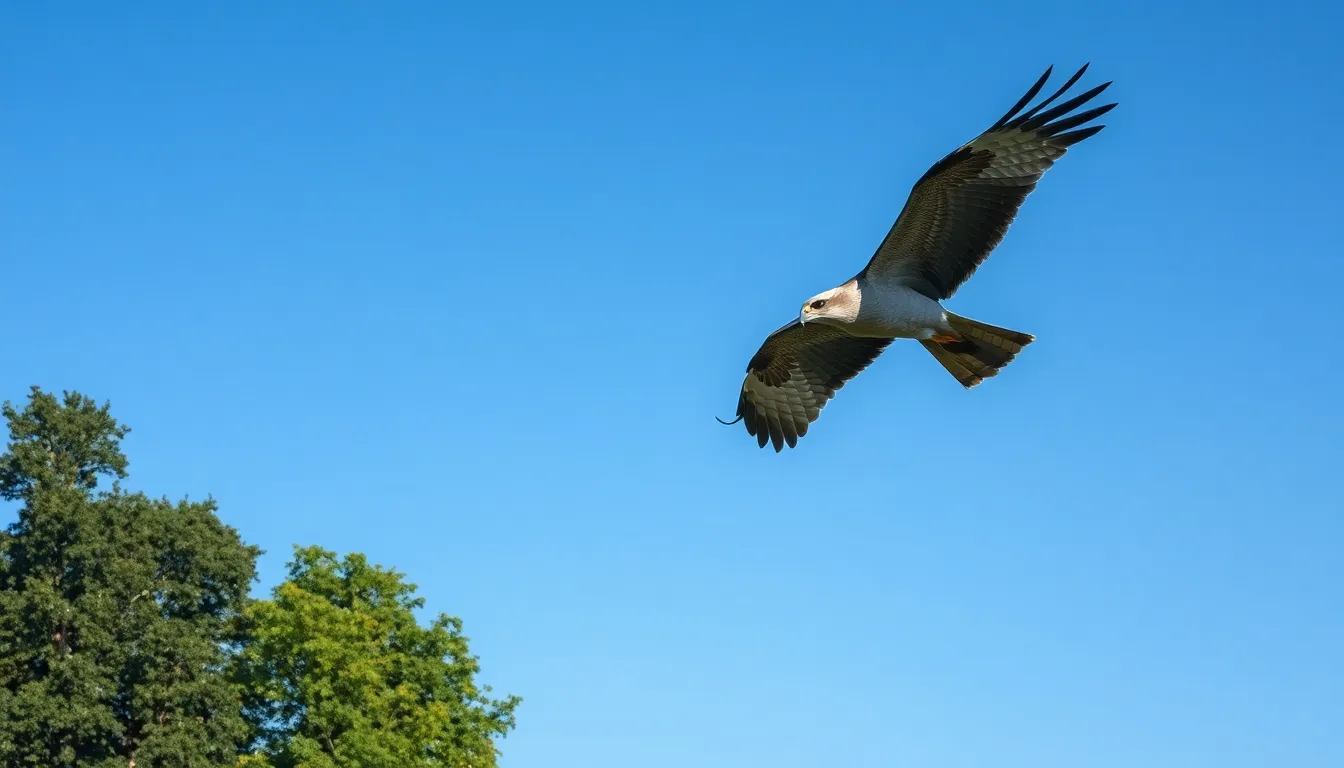
Kite birds demonstrate fascinating reproductive behaviors that vary significantly across species and geographic regions. We observe complex courtship displays and strategic nesting choices that maximize breeding success rates.
Mating Rituals
Red Kites perform spectacular aerial courtship displays that include synchronized soaring, talon grappling, and dramatic diving sequences. Males typically initiate these displays by executing high-altitude loops while calling to attract females below. The birds engage in mutual talon locking, spinning through the air in cartwheel formations that can last up to 30 seconds.
Black Kites exhibit different mating behaviors depending on their geographic location. European populations perform undulating flight patterns accompanied by distinctive mewing calls during March and April breeding seasons. Australian Black Kites create elaborate stick-dropping ceremonies where males present nesting materials to potential mates. The courtship period extends 2-3 weeks before pair bonding occurs.
Mississippi Kites engage in graceful aerial dances characterized by side-by-side gliding and synchronized turning maneuvers. Pairs perform these courtship flights at heights between 100-200 feet above their nesting territories. The male demonstrates hunting prowess by catching insects mid-flight and presenting them to the female during courtship feeding rituals.
Nest Construction and Location
Kite species construct platform nests using sticks, twigs, and various organic materials gathered within a 2-mile radius of their chosen sites. Red Kites build substantial nests measuring 24-36 inches in diameter, often reusing the same location for multiple breeding seasons. These structures typically occupy oak or beech tree forks at heights between 40-80 feet above ground level.
Black Kites demonstrate remarkable adaptability in nest placement, utilizing cliff ledges, urban structures, and traditional tree sites depending on habitat availability. Urban populations frequently nest on building ledges, transmission towers, and bridge supports in cities across Europe and Asia. The nests measure 18-30 inches across and incorporate unusual materials like plastic bags, rope fragments, and metal scraps.
Mississippi Kites prefer tall deciduous trees near water sources for optimal nesting conditions. Cottonwood, elm, and sycamore trees serve as primary nesting sites, with most nests positioned 30-60 feet high in major branch forks. Colony nesting occurs in prime habitats where 5-15 pairs establish territories within 100-yard distances of each other.
Conservation Status and Threats
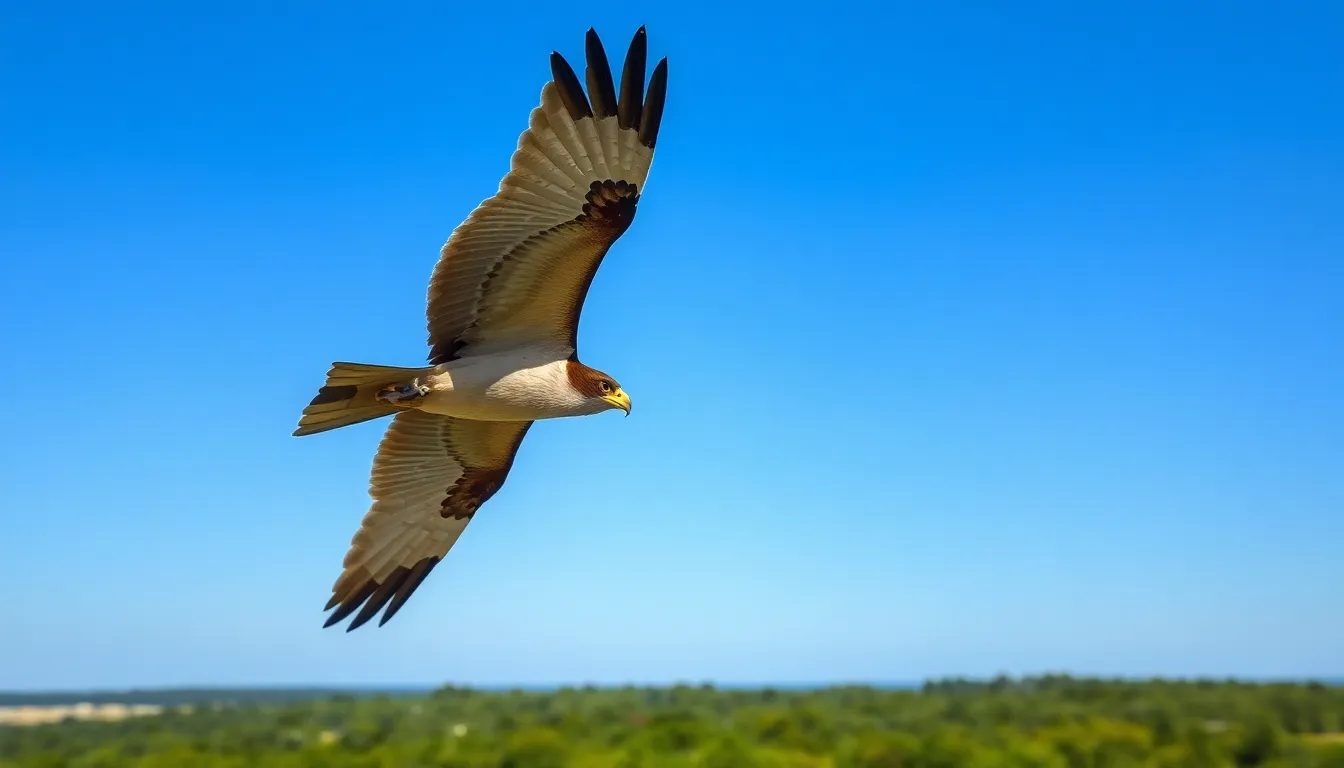
Kite bird populations face varying conservation challenges across species and regions. We observe distinct patterns in population recovery and decline among different kite species worldwide.
Population Trends
Red Kites experienced dramatic population declines during the 20th century, dropping to fewer than 60 breeding pairs in Wales by 1979. Reintroduction programs increased UK populations to over 4,600 breeding pairs by 2020. European Red Kite populations now exceed 60,000 breeding pairs across their range.
Black Kites maintain stable global populations exceeding 6 million individuals. Asian populations show consistent growth patterns in urban environments. Australian Black Kites demonstrate population stability with localized increases near agricultural areas.
Mississippi Kites recovered from historical lows of 200 breeding pairs in the 1960s to current populations exceeding 100,000 individuals. Great Plains populations expanded northward by approximately 300 miles since 1980. Breeding range expansion continues across 15 US states.
| Species | Population Status | Breeding Pairs/Individuals | Trend |
|---|---|---|---|
| Red Kite | Recovering | 60,000+ pairs | Increasing |
| Black Kite | Stable | 6+ million individuals | Stable |
| Mississippi Kite | Recovered | 100,000+ individuals | Increasing |
| Snail Kite | Endangered | 3,000-4,000 individuals | Declining |
Human Impact and Protection Efforts
Habitat destruction affects kite bird populations through wetland drainage and urban development. Agricultural intensification reduces carrion availability and nesting sites for multiple kite species. Power line collisions cause 15-20% mortality rates among migrating kites annually.
Poisoning incidents from illegal pesticide use continue to impact Red Kite populations in Europe. Lead ammunition creates secondary poisoning risks when kites consume shot game animals. Climate change alters prey distribution patterns and affects migration timing across kite species.
Protected area designation covers 40% of critical kite habitats globally. Captive breeding programs successfully reintroduced Red Kites to England, Scotland and Ireland between 1989-2010. Wind turbine placement regulations now require 1-kilometer buffers from major kite roosting sites.
Conservation organizations monitor 2,500+ kite nest sites annually across North America and Europe. Educational programs reach 50,000+ people yearly through kite watching events and school presentations. International cooperation agreements protect migratory corridors spanning 30+ countries for various kite species.
Kite Birds in Culture and Mythology
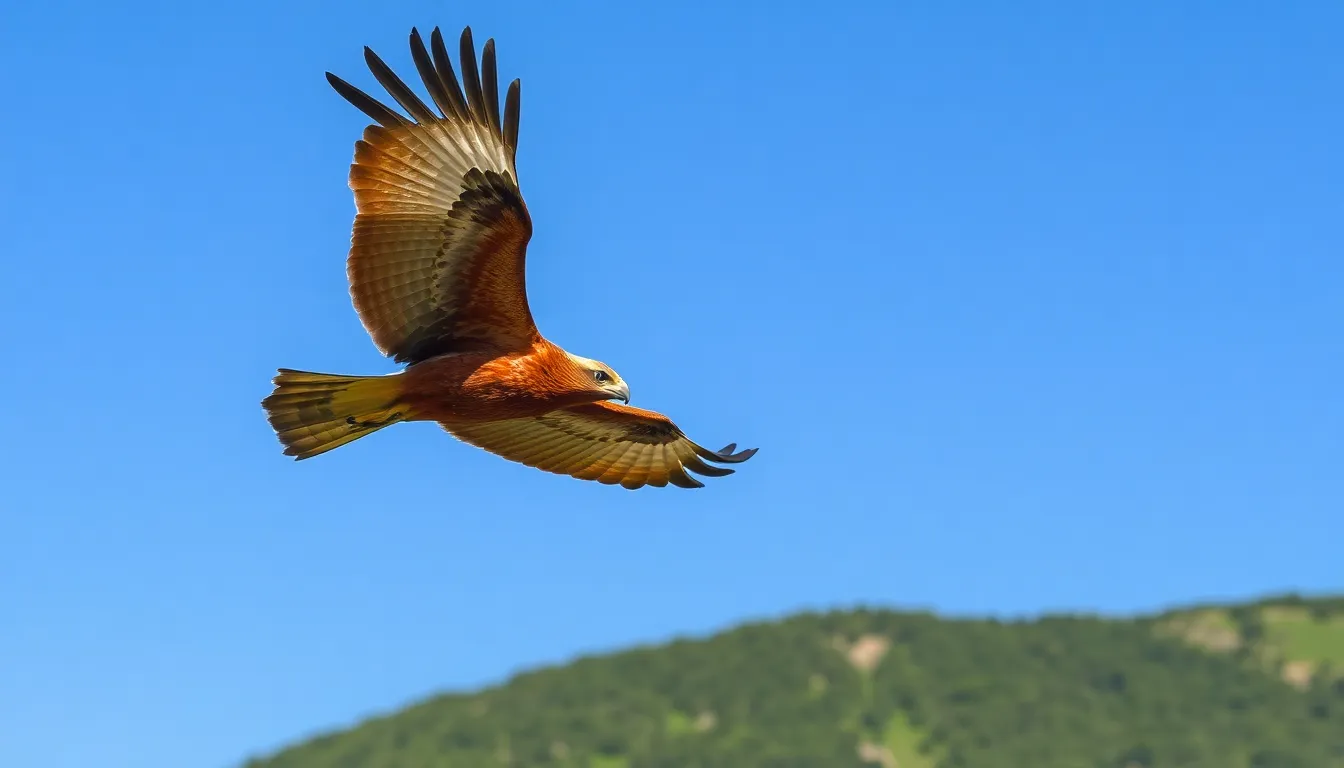
Ancient civilizations across the globe have woven kite birds into their most sacred stories and cultural beliefs. Egyptian mythology portrays these raptors as divine messengers, with the Red Kite specifically representing the soul’s journey to the afterlife. Celtic druids considered kite birds symbols of prophecy and wisdom, often observing their flight patterns to predict weather changes and seasonal shifts.
Greek mythology connects kite birds to the story of Nisus, the king of Megara who transformed into a sea eagle or kite after his death. Hindu texts describe the Brahminy Kite as Garuda’s messenger, carrying prayers between earth and heaven. Aboriginal Australian cultures view kite birds as ancestral spirits that guide lost souls back to their tribal lands.
Medieval European folklore painted kite birds as both harbingers of war and symbols of maternal protection. Knights observed Red Kites circling battlefields, interpreting their presence as omens of victory or defeat. Welsh legends describe the Red Kite as the “Royal Bird of Wales,” earning protection under ancient laws that punished anyone who harmed these majestic creatures.
Japanese culture celebrates the Black Kite as “Tobi,” featuring prominently in traditional art and poetry. These birds represent adaptability and intelligence in Shinto beliefs, with their opportunistic feeding habits symbolizing survival wisdom. Chinese mythology associates kite birds with wind spirits, believing their soaring abilities connect the earthly and celestial realms.
Native American tribes across the Great Plains consider the Mississippi Kite a sacred messenger of change and transformation. Lakota traditions describe these birds as carriers of visions, appearing before important tribal events or seasonal transitions. Cherokee folklore connects kite birds to the Thunder Beings, powerful spirits that control weather patterns and natural cycles.
Modern conservation movements have elevated kite birds to symbols of environmental restoration and wildlife protection. The Red Kite’s recovery in Britain became a conservation success story that inspired similar efforts across Europe. Contemporary birdwatching communities celebrate these raptors as indicators of network health, with their presence signaling balanced natural environments.
Art and literature continue to feature kite birds as symbols of freedom and grace. Victorian poets compared their soaring flight to human aspirations for spiritual elevation. Modern wildlife photographers capture their elegant aerial displays, creating images that reinforce cultural connections between these birds and natural beauty.
Best Places to Observe Kite Birds
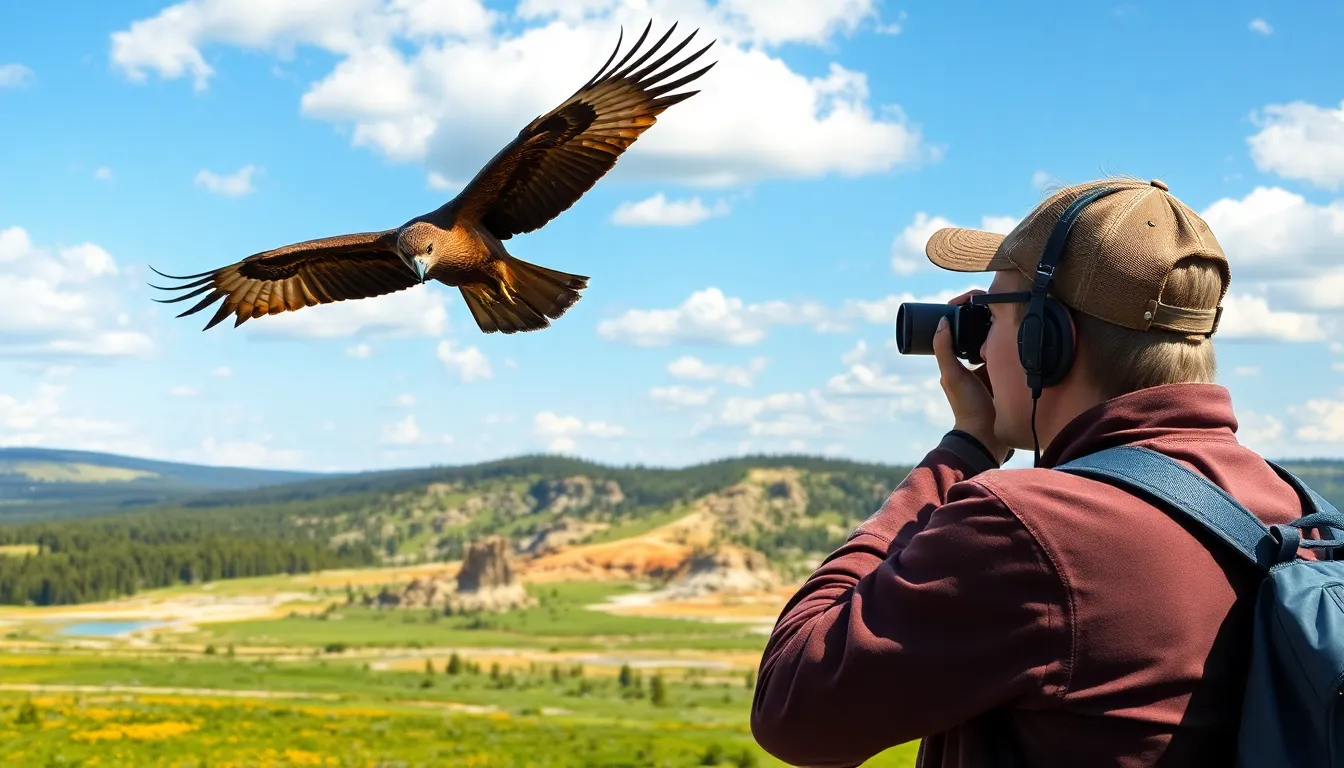
Yellowstone National Park offers exceptional kite bird viewing opportunities throughout the western United States. Black Kites congregate near the park’s thermal features during summer months, while Red Kites soar above meadow areas in early morning hours. Visitors often spot Mississippi Kites along riverbanks between May and August.
Europe’s prime kite observation locations include the Chiltern Hills in England where Red Kite populations exceed 4,000 breeding pairs. Wales supports over 2,000 Red Kite pairs across mid-Wales valleys and mountains. Scotland’s highlands provide viewing opportunities near Galloway Forest Park where reintroduction programs have established thriving populations.
| Location | Primary Species | Best Viewing Season | Peak Population |
|---|---|---|---|
| Yellowstone National Park | Black Kite, Mississippi Kite | May – August | 800+ individuals |
| Chiltern Hills, England | Red Kite | March – September | 4,000+ breeding pairs |
| Mid-Wales Valleys | Red Kite | Year-round | 2,000+ breeding pairs |
| Kruger National Park | Black Kite, Yellow-billed Kite | October – March | 15,000+ individuals |
| Extremadura, Spain | Red Kite, Black Kite | February – October | 6,500+ breeding pairs |
Africa’s Kruger National Park attracts massive kite concentrations during southern hemisphere summer. Yellow-billed Kites and Black Kites gather in flocks exceeding 15,000 individuals near water sources. Game drives between October and March offer optimal viewing conditions when thermal currents support extended soaring behaviors.
Spain’s Extremadura region hosts Europe’s largest kite populations with over 6,500 breeding pairs across dehesa landscapes. Red Kites and Black Kites share territories near cattle ranches where carrion provides abundant food sources. Organized birding tours operate from Trujillo and Cáceres during peak breeding seasons.
Australia’s coastal wetlands support resident kite populations year-round. Whistling Kites frequent Queensland’s Moreton Bay Marine Park where fish populations attract consistent feeding activity. New South Wales coastal areas provide viewing opportunities at Lake Macquarie and Myall Lakes National Park.
American midwest locations include Oklahoma’s Tallgrass Prairie Preserve where Mississippi Kites nest in riverside cottonwoods. Texas Hill Country supports breeding populations along the Guadalupe River corridor. Arkansas’s Buffalo National River offers exceptional viewing during spring migration periods when hundreds of Mississippi Kites travel northward.
Urban kite observation opportunities exist in major metropolitan areas worldwide. London’s parks host Red Kites that venture from surrounding countryside populations. Delhi’s outskirts support Black Kite communities that exploit urban waste streams and thermal updrafts from concrete surfaces.
Timing visits during early morning hours between 7:00 AM and 10:00 AM maximizes kite sighting opportunities. Thermal currents develop during these periods, enabling efficient soaring behaviors that make kites visible from greater distances. Weather conditions with light winds and clear skies provide optimal viewing circumstances for observing flight patterns and feeding behaviors.
Equipment recommendations include 8×42 binoculars for general observation and 10×50 models for distant viewing. Spotting scopes with 20-60x magnification reveal detailed plumage characteristics and behavioral interactions. Field guides exact to regional kite species enhance identification accuracy during observation sessions.
Conclusion
We’ve explored the remarkable industry of kite birds and discovered why these aerial masters deserve our admiration and protection. From their impressive soaring abilities to their crucial ecological roles these raptors continue to adapt and thrive across diverse environments worldwide.
Our journey through their behaviors habitats and cultural significance reveals just how interconnected we are with these magnificent creatures. Whether you’re planning your first kite-watching expedition or simply gained a new appreciation for these birds we hope this knowledge inspires you to support their conservation.
The next time you spot a kite gracefully riding the thermals above remember that you’re witnessing millions of years of evolutionary perfection in action. These birds remind us that nature’s resilience combined with dedicated conservation efforts can create truly inspiring success stories.
Frequently Asked Questions
What are kite birds and how are they different from other raptors?
Kite birds are medium-sized raptors belonging to the family Accipitridae, characterized by their angular wings, light build, and graceful soaring abilities. Unlike many raptors that actively hunt prey, kites are opportunistic feeders that often scavenge and exploit various food sources including fish, small mammals, insects, and carrion. They typically measure 20-26 inches in length with wingspans ranging from 43-60 inches.
How many species of kite birds exist and where are they found?
There are over 20 kite species distributed across six continents worldwide. Notable examples include the Red Kite found in Europe and Asia, the Black Kite with global presence, and the Mississippi Kite in North America. Most kites favor open landscapes near water sources, though habitat preferences vary among species, with some adapting to urban environments and agricultural areas.
What do kite birds eat and how do they hunt?
Kite birds are opportunistic feeders with diverse diets that vary by species. Red Kites rely heavily on carrion, Black Kites scavenge near human activity, and Mississippi Kites specialize in catching aerial insects. They employ passive hunting methods, using thermal currents to conserve energy while surveying for food. Fish serves as an important protein source for coastal kite populations.
What are the physical characteristics of kite birds?
Kite birds feature angular wing shapes, forked tails, and varied plumage coloration that enhance their soaring abilities. Red Kites are among the largest with impressive wingspans and russet plumage, while Mississippi Kites are smaller. They have relatively weak feet and talons compared to more aggressive raptors, and their beak structure reflects their scavenging habits rather than active predation.
How do kite birds reproduce and build their nests?
Kite birds exhibit complex courtship behaviors including synchronized soaring and aerial displays. Red Kites build substantial nests in deciduous trees, Black Kites adapt to urban environments for nesting, and Mississippi Kites prefer tall trees near water sources. Reproductive behaviors vary significantly across species and regions, with each species having unique mating rituals and nest construction preferences.
What is the conservation status of kite birds?
Conservation status varies among species. Red Kites have successfully recovered from near extinction in the UK through conservation efforts, while Black Kites maintain stable global populations. Mississippi Kites have also rebounded significantly, but some species like the Snail Kite remain endangered. Threats include habitat destruction, agricultural practices, and climate change, making conservation efforts crucial for their survival.
Where are the best places to observe kite birds?
Prime kite bird watching locations include Yellowstone National Park (U.S.), Chiltern Hills (England), and Kruger National Park (South Africa). These sites offer opportunities to observe various kite species during specific seasons. Optimal viewing times are typically during migration periods and breeding seasons. Recommended equipment includes binoculars and field guides for proper identification and enhanced viewing experience.
What cultural significance do kite birds hold?
Kite birds have deep cultural significance across civilizations, appearing in mythology and folklore worldwide. They’ve been viewed as divine messengers in Egyptian mythology, symbols of prophecy in Celtic traditions, and sacred messengers in Native American beliefs. Japanese art frequently celebrates these birds, and modern conservation movements have elevated their status as symbols of environmental restoration and protection.

